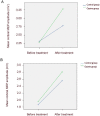Major ozonated autohemotherapy promotes the recovery of upper limb motor function in patients with acute cerebral infarction
- PMID: 25206688
- PMCID: PMC4146136
- DOI: 10.3969/j.issn.1673-5374.2013.05.010
Major ozonated autohemotherapy promotes the recovery of upper limb motor function in patients with acute cerebral infarction
Abstract
Major ozonated autohemotherapy is classically used in treating ischemic disorder of the lower limbs. In the present study, we performed major ozonated autohemotherapy treatment in patients with acute cerebral infarction, and assessed outcomes according to the U.S. National Institutes of Health Stroke Score, Modified Rankin Scale, and transcranial magnetic stimulation motor-evoked potential. Compared with the control group, the clinical total effective rate and the cortical potential rise rate of the upper limbs were significantly higher, the central motor conduction time of upper limb was significantly shorter, and the upper limb motor-evoked potential amplitude was significantly increased, in the ozone group. In the ozone group, the National Institutes of Health Stroke Score was positively correlated with the central motor conduction time and the motor-evoked potential amplitude of the upper limb. Central motor conduction time and motor-evoked potential amplitude of the upper limb may be effective indicators of motor-evoked potentials to assess upper limb motor function in cerebral infarct patients. Furthermore, major ozonated autohemotherapy may promote motor function recovery of the upper limb in patients with acute cerebral infarction.
Keywords: National Institutes of Health Stroke Score; amplitude; central motor conduction time; cerebral infarction; clinical practice; evoked potential; grants-supported paper; motor; motor function; neural regeneration; neuroregenertion; ozone; photographs-containing paper; upper limb paralysis; upper limbs.
Conflict of interest statement
Figures



Similar articles
-
Magnetic resonance diffusion tensor imaging following major ozonated autohemotherapy for treatment of acute cerebral infarction.Neural Regen Res. 2016 Jul;11(7):1115-21. doi: 10.4103/1673-5374.187046. Neural Regen Res. 2016. PMID: 27630695 Free PMC article.
-
Effects of different frequencies of repetitive transcranial magnetic stimulation on the recovery of upper limb motor dysfunction in patients with subacute cerebral infarction.Neural Regen Res. 2016 Oct;11(10):1584-1590. doi: 10.4103/1673-5374.193236. Neural Regen Res. 2016. PMID: 27904488 Free PMC article.
-
Relationship Between Motor Function, DTI, and Neurophysiological Parameters in Patients with Stroke in the Recovery Rehabilitation unit.J Stroke Cerebrovasc Dis. 2021 Aug;30(8):105889. doi: 10.1016/j.jstrokecerebrovasdis.2021.105889. Epub 2021 May 29. J Stroke Cerebrovasc Dis. 2021. PMID: 34062310
-
Non-Invasive Brain Stimulation to Enhance Post-Stroke Recovery.Front Neural Circuits. 2016 Jul 27;10:56. doi: 10.3389/fncir.2016.00056. eCollection 2016. Front Neural Circuits. 2016. PMID: 27512367 Free PMC article. Review.
-
Molecular effects of ozone on amino acids and proteins, especially human hemoglobin and albumin, and the need to personalize ozone concentration in major ozone autohemotherapy.Crit Rev Clin Lab Sci. 2023 Aug;60(5):382-397. doi: 10.1080/10408363.2023.2185765. Epub 2023 Mar 11. Crit Rev Clin Lab Sci. 2023. PMID: 36905208 Review.
Cited by
-
Ozone high dose therapy (OHT) improves mitochondrial bioenergetics in peripheral blood mononuclear cells.Transl Med Commun. 2022;7(1):17. doi: 10.1186/s41231-022-00123-7. Epub 2022 Jul 21. Transl Med Commun. 2022. PMID: 35880042 Free PMC article.
-
Application of ozone therapy in interventional medicine.J Interv Med. 2019 Jun 27;2(1):8-11. doi: 10.1016/j.jimed.2019.05.003. eCollection 2019 Feb. J Interv Med. 2019. PMID: 34805862 Free PMC article.
-
Effects of adjuvant ozone autohemotherapy combined with routine treatment on clinical and paraclinical features of mechanically ventilated COVID-19 patients in the intensive care unit: a pilot randomized controlled trial.Med Gas Res. 2024 Apr-Jun;14(2):67-74. doi: 10.4103/2045-9912.385439. Med Gas Res. 2024. PMID: 37929510 Free PMC article. Clinical Trial.
-
Effects of major air pollutants on angina hospitalizations: a correlation study.BMC Public Health. 2024 Jul 15;24(1):1877. doi: 10.1186/s12889-024-19380-2. BMC Public Health. 2024. PMID: 39004712 Free PMC article.
-
Association between short-term exposure to air pollution and ischemic stroke onset: a time-stratified case-crossover analysis using a distributed lag nonlinear model in Shenzhen, China.Environ Health. 2020 Jan 2;19(1):1. doi: 10.1186/s12940-019-0557-4. Environ Health. 2020. PMID: 31898503 Free PMC article.
References
-
- Giunta R, Coppola A, Luongo C, et al. Ozonized autohemotransfusion improves hemorheological parameters and oxygen delivery to tissues in patients with peripheral occlusive arterial disease. Ann Hematol. 2001;80(12):745–748. - PubMed
-
- Romero Valdés A, Menéndez Cepero S, Gómez Moraleda M, et al. Ozone therapy in the advanced stages of arteriosclerosis obliterans. Angiología. 1993;45(4):146–148. - PubMed
-
- Bocci V. The case for oxygen-ozone therapy. Br J Biomed Sci. 2007;64(1):44–49. - PubMed
-
- Bocci V, Borrelli E, Travagli V, et al. The ozone paradox: ozone is a strong oxidant as well as a medical drug. Med Res Rev. 2009;29(4):646–682. - PubMed
-
- Tylicki L, Niew GT, Biedunkiewicz B, et al. Beneficial clinical effects of ozonated autohemotherapy in chronically dialysed patients with atherosclerotic ischemia of the lower limbs. Int J Artif Organs. 2001;24(2):79–82. - PubMed
LinkOut - more resources
Full Text Sources
